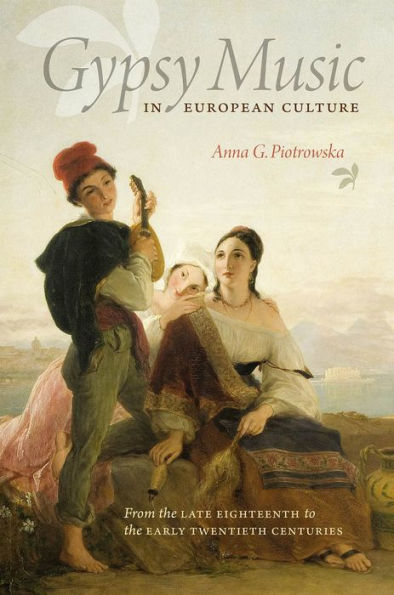Gypsy Music in European Culture: From the Late Eighteenth to the Early Twentieth Centuries
Translated from the Polish, Anna G. Piotrowska’s Gypsy Music in European Culture details the profound impact that Gypsy music has had on European culture from a broadly historical perspective. The author begins by identifying two models of discourse on Gypsy music: those of assimilation, as in the national music of Hungary and Spain, and nonassimilating types, which often fall into racial stereotypes and associations with the exotic. Using these broad typologies as a jumping-off point, she then details the stimulating influence that Gypsy music had on a variety of European musical forms, including opera, vaudeville, ballet, and vocal and instrumental compositions. The author analyzes the use of Gypsy themes and idioms in the music of recognized giants such as Bizet, Strauss, and Paderewski, detailing the composers’ use of scale, form, motivic presentations, and rhythmic tendencies, and also discusses the impact of Gypsy music on emerging national musical forms.This is the first comprehensive treatment of Gypsy musical forms and their impact on European musical taste and styles from the eighteenth to the twentieth centuries and will be welcomed by scholars and students in ethnomusicology, anthropology, cultural studies, and the history of music.
1115195572
Gypsy Music in European Culture: From the Late Eighteenth to the Early Twentieth Centuries
Translated from the Polish, Anna G. Piotrowska’s Gypsy Music in European Culture details the profound impact that Gypsy music has had on European culture from a broadly historical perspective. The author begins by identifying two models of discourse on Gypsy music: those of assimilation, as in the national music of Hungary and Spain, and nonassimilating types, which often fall into racial stereotypes and associations with the exotic. Using these broad typologies as a jumping-off point, she then details the stimulating influence that Gypsy music had on a variety of European musical forms, including opera, vaudeville, ballet, and vocal and instrumental compositions. The author analyzes the use of Gypsy themes and idioms in the music of recognized giants such as Bizet, Strauss, and Paderewski, detailing the composers’ use of scale, form, motivic presentations, and rhythmic tendencies, and also discusses the impact of Gypsy music on emerging national musical forms.This is the first comprehensive treatment of Gypsy musical forms and their impact on European musical taste and styles from the eighteenth to the twentieth centuries and will be welcomed by scholars and students in ethnomusicology, anthropology, cultural studies, and the history of music.
26.49
In Stock
5
1

Gypsy Music in European Culture: From the Late Eighteenth to the Early Twentieth Centuries
272
Gypsy Music in European Culture: From the Late Eighteenth to the Early Twentieth Centuries
272
26.49
In Stock

Product Details
| ISBN-13: | 9781555538385 |
|---|---|
| Publisher: | Northeastern University Press |
| Publication date: | 03/10/2014 |
| Sold by: | Barnes & Noble |
| Format: | eBook |
| Pages: | 272 |
| File size: | 3 MB |
About the Author
What People are Saying About This
From the B&N Reads Blog
